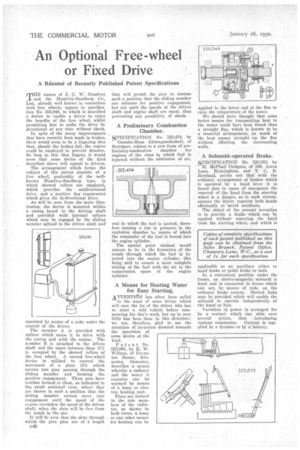An Optional Free-wheel or Fixed Drive
Page 70

If you've noticed an error in this article please click here to report it so we can fix it.
A Resume of Recently Published Patent Specifications TE names of J. C. W. Hurrifrey and the Humfrey-Sandberg Co., Ltd., already well known in connection with free wheels, appear in specification No. 323,048, in which is described a device to enable a driver to enjoy the benefits of the free wheel, whilst permitting him to make the drive bidirectional at any time without shock.
In spite of the many improvements that have recently been made in brakes, there would seem to be a lingering idea that, should the brakes fail, the engine could be employed to prevent disaster. So long as this idea lingers, it would seem that some device of the kind described above will appeal to drivers.
The arrangement which forms the subject of this patent consists of a free wheel, preferably of the wellknown Eumfrey-Sandberg type, in which skewed rollers are employed, which provides the unidirectional drive, and a positive dog engagement which gives the hi-directional drive.
As will be seen from the main illustration, the device is mounted within a casing keyed to the driving shaft and provided with internal spl:nes which, may be engaged by the sliding member splined to the driven shaft and operated by means of a yoke under the control of . the driver.
The member A is provided with splines which cause it to drive with the easing and with the engine. The member_ B is attached to the &Wen' shaft and the space between them (C) is occupied by the skewed rollers of the free wheel. A second free-wheel device is utilized to control the movement of a plate (D) which carries two pins passing through the sliding member and forming the positive engagement. These pins have notches formed in them, as indicated in the. small sectional view, where they are shown in such a position that the sliding member cannot move into engagement until the speed of the ckgine overtakes the speed of the driven shaft; when the slots will be free from
the notch in the pin. • It will be seen that the slots through which: the pins pass are of a length c48 1hat will permit the pins to assume such a position that the sliding member can advance for positive engagement, but not until the speeds of the driven shaft and engine shaft are equal, thus preventing any possibility of shock.
A Preliminary Combustion Chamber.
SPECIFICATION No. 322,474, by Daimler-Benz Aktiengesellschaft, of Stuttgart, relates to a new form of preliminary-combustion chamber for engines of the class in which fuel is injected without the admission of air,
and in which the fuel is ignited, therefore causing a rise in pressure in the explosion chamber by means a which the remainder of the fuel is forced into the engine cylinder.
The special point claimed would appear to lie in the formation of the nozzle through which the fuel is injected into the engine cylinder, this being said to ensure a more complete mixing of the fuel with the air in the compression space of the engine cylinder.
A Means for Heating Water for Easy Starting.
ATTENTAN has often been called
to the want of some device which will ease the lot of the driver who has to start a cold vehicle before commencing his day's work, but up to now little has been done in this direction ; we are, therefore, glad to see the attention of inventors directed towards the provision of some device of the kind.
Patent No. 1128,091, by K. W. Willans, of Doveston House, Kinnerley, • Oswestry, describes a means whereby a radiator and the water it contains can be warmed by means of a lamp or electric heating unit.
Flues are formed in the side members of the radiator, as shown in both views. A lamp or any other means for heating can be applied to the lower end of the flue to raise the temperature of the water.
We should have thought that some better means for transmitting heat to the water could have been found than a straight flue, which is known to be a wasteful arrangement, as much of the heat passes straight up the flue without affecting the surrounding walls.
A Solenoid-operated Brake, SPECIFICATION No. 1123,072, by
H. McPhail Dudgeon, of 169, Aston Lane, Birmingham, and T. C. E. Rowland, points out that with the ordinary arrangement of brakes which is operated by a hand lever it is found that in cases of emergency the removal of the hand from the steering wheel is a danger, as in such circumstances the driver requires both hands effectually to avoid accidents.
The object of the present invention is to provide a brake which can be applied without removing the hand from the steering wheel, and which is
applicable as an auxiliary either to hand brake or pedal brake or both.
In a convenient position under the frame, an electro-magnetic solenoid is fixed and is connected to levers which can act, by means of rods, on the ordinary brake system. Slotted links may be provided which will enable the solenoid to operate independently of the hand or Toot.
Variation of power is arranged for by a contact which can slide over several points, thus . introducing
various resistances. Current is supplied by a dynamo or by a battery.












































































































